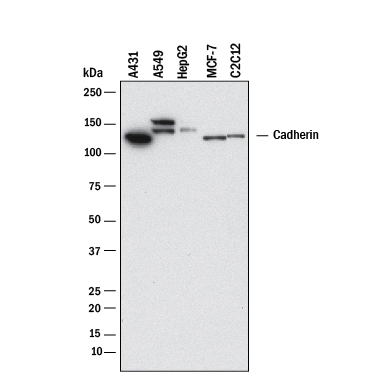Human/Mouse Cadherin Pan Specific Antibody
R&D Systems, part of Bio-Techne | Catalog # MAB18385

Key Product Details
Species Reactivity
Validated:
Applications
Label
Antibody Source
Product Summary for Human/Mouse Cadherin Pan Specific Antibody
Immunogen
Accession # P12830
Specificity
Clonality
Host
Isotype
Scientific Data Images for Human/Mouse Cadherin Pan Specific Antibody
Detection of Human and Mouse Cadherin by Western Blot.
Western blot shows lysates of A431 human epithelial carcinoma cell line, A549 human lung carcinoma cell line, HepG2 human hepatocellular carcinoma cell line, MCF-7 human breast cancer cell line, and C2C12 mouse myoblast cell line. PVDF membrane was probed with 1 µg/mL of Mouse Anti-Human/Mouse Cadherin Pan Specific Monoclonal Antibody (Catalog # MAB18385) followed by HRP-conjugated Anti-Mouse IgG Secondary Antibody (Catalog # HAF018). Specific bands were detected for Cadherin at approximately 135 kDa (as indicated). This experiment was conducted under reducing conditions and using Immunoblot Buffer Group 1.Cadherin in Human Cystadenocarcinoma.
Cadherin was detected in immersion fixed paraffin-embedded sections of human papillary serous cystadenocarcinoma of the colon using Mouse Anti-Human/Mouse Cadherin Pan Specific Monoclonal Antibody (Catalog # MAB18385) at 5 µg/mL for 1 hour at room temperature followed by incubation with the Anti-Mouse IgG VisUCyte™ HRP Polymer Antibody (Catalog # VC001). Before incubation with the primary antibody, tissue was subjected to heat-induced epitope retrieval using Antigen Retrieval Reagent-Basic (Catalog # CTS013). Tissue was stained using DAB (brown) and counterstained with hematoxylin (blue). Specific staining was localized to plasma membrane. View our protocol for IHC Staining with VisUCyte HRP Polymer Detection Reagents.Detection of Human Cadherins by Western Blot.
Western blot shows lysates of HEK293T human embryonic kidney cell line mock transfected or transfected with human E-Cadherin and NS0 mouse myeloma cell line transfected with Human P-Cadherin, N-Cadherin, or mock transfected. PVDF membrane was probed with 1 µg/mL of Mouse Anti-Human/Mouse Cadherin Pan Specific Monoclonal Antibody (Catalog # MAB18385) followed by HRP-conjugated Anti-Mouse IgG Secondary Antibody (Catalog # HAF018). A specific band was detected for Cadherin at approximately 135 kDa (as indicated). This experiment was conducted under reducing conditions and using Immunoblot Buffer Group 1.Applications for Human/Mouse Cadherin Pan Specific Antibody
Immunohistochemistry
Sample: Immersion fixed human papillary serous cystadenocarcinoma of the colon
Western Blot
Sample: A431 human epithelial carcinoma cell line, A549 human lung carcinoma cell line, HepG2 human hepatocellular carcinoma cell line, MCF‑7 human breast cancer cell line, C2C12 mouse myoblast cell line, HEK293T human embryonic kidney cell line, HEK293T human embryonic kidney cell line transfected with human E-Cadherin, and NS0 mouse myeloma cell line transfected with Human P-Cadherin or N-Cadherin
Reviewed Applications
Read 1 review rated 5 using MAB18385 in the following applications:
Formulation, Preparation, and Storage
Purification
Reconstitution
Formulation
Shipping
Stability & Storage
- 12 months from date of receipt, -20 to -70 °C as supplied.
- 1 month, 2 to 8 °C under sterile conditions after reconstitution.
- 6 months, -20 to -70 °C under sterile conditions after reconstitution.
Background: Cadherin
Epithelial (E)‑Cadherin (ECAD), also known as Cadherin-1, cell-CAM120/80 in the human, uvomorulin in the mouse, Arc-1 in the dog, and L-CAM in the chicken, is a member of the Cadherin family of cell adhesion molecules (gene name CDH1). Cadherins are calcium-dependent transmembrane proteins which bind to one another in a homophilic manner. On their cytoplasmic side, they associate with the three catenins, alpha, beta, and gamma (plakoglobin). This association links the cadherin protein to the cytoskeleton. Without association with the catenins, the cadherins are non-adhesive. Cadherins play a role in development, specifically in tissue formation. They may also help to maintain tissue architecture in the adult. E-Cadherin may also play a role in tumor development, as loss of E-Cadherin has been associated with tumor invasiveness. E-Cadherin is a classical cadherin molecule. Classical cadherins consist of a large extracellular domain which contains DXD and DXNDN repeats responsible for mediating calcium‑dependent adhesion, a single-pass transmembrane domain, and a short carboxy-terminal cytoplasmic domain responsible for interacting with the catenins. E‑Cadherin contains five extracellular calcium-binding domains of approximately 110 amino acids each (amino acids 155-697).
References
- Bussemakers, M.J.G. et al. (1993) Mol. Biol. Reports 17:123.
- Overduin, M. et al. (1995) Science 267:386.
- Takeichi, M. (1991) Science 251:1451.
Long Name
Alternate Names
Entrez Gene IDs
Gene Symbol
UniProt
Additional Cadherin Products
Product Documents for Human/Mouse Cadherin Pan Specific Antibody
Product Specific Notices for Human/Mouse Cadherin Pan Specific Antibody
For research use only


